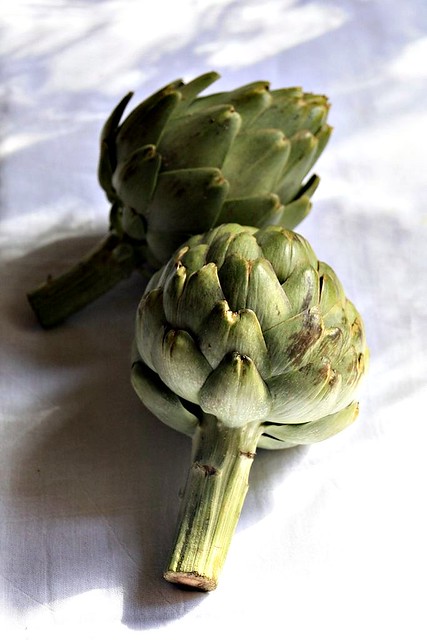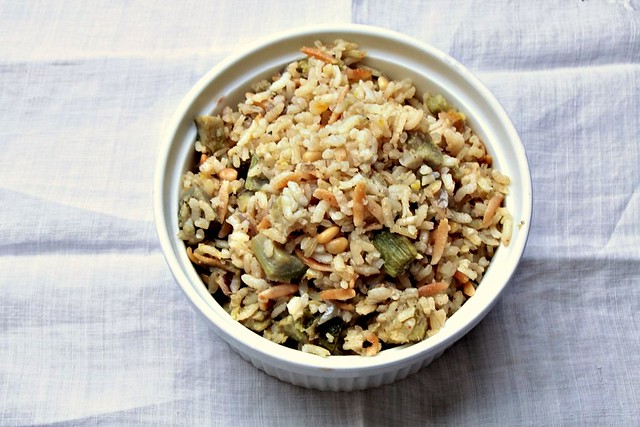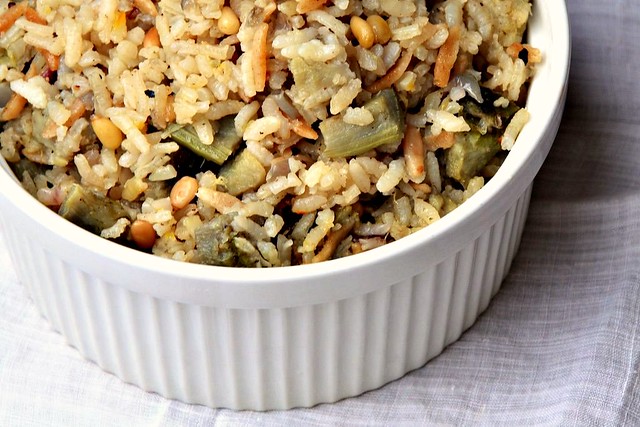An Artichoke “How To” and a Pilaf
It’s a challenge to avoid the huge artichokes in the markets right now. Maybe not at your market, but mine has them planted right in front of the entrance, so you can’t miss them. It’s sort of an in-your-face-buy-me display that changes depending on any number of factors that I won’t go on about right now. I can usually maneuver past them because they’re so expensive, and as much as I love them, I balk at $4 for one — especially when I can pick up a can of hearts to do something with much more easily. And in the long run, it’s more safe when you think about tackling those chokes, isn’t it?
Artichokes have a dual personality in my opinion. There’s the real McCoy — the one you steam in a pot, then enjoy with myriad detours to a bowl of warm lemon butter (never mayonnaise if you’re in this house) that each piece is dipped into, then scraped along your lower teeth. I grew up eating artichokes like this and it was quite an occasion when my mother brought one home. Then there are the little hearts, all taken care of, canned, bottled or frozen and ready for any number of delicious dishes. Thank goodness these choices are available, because waiting until artichoke season to enjoy them would be a problem for me at this point. I love artichokes.
As I recall the image of our family of five seated around the kitchen table with one huge artichoke and a bowl of lemon butter, I have to wonder. I always looked forward to it, but do the math. Not many bites for each of us even when taking into consideration my sister probably didn’t like them. This occasion for artichokes was never a precursor to dinner. It was all about that artichoke — savored petal by delicious petal. Bear in mind the petals were never trimmed, so dealing with the spikes on those tough outer petals involved a lot of caution after the first thumb prick, or a silent sucking it up for each subsequent prick.
It occurs to me we never ate the heart — or at least I don’t remember that we did. Maybe my stepfather sneaked away with it after we’d lost interest because the lemon butter was gone. I can see him now, perhaps standing at the kitchen counter enjoying the fact that the hard work had been done by us, and all he had to do was take a spoon, scrape away the fuzzy choke, then savor that amazing heart without having to share. Denying us awareness of something wonderful. Scarring us for life.
I could ask my mother about what happened to all those years of artichoke hearts, but she’d say she doesn’t remember. There would be a few seconds of silence before she’d add she probably threw them away. Can you imagine? I can, because I threw them away, too, until I discovered marinated artichoke hearts sometime in my early 20s and put two and two together. I had no clue they could be eaten.
If they weren’t such a challenge and expense, I’d enjoy them fresh more often in dishes like this lovely pilaf made with rice, orzo, pine nuts, and saffron.
Are you an artichoke lover? If so, how do you prepare them?
Artichoke Pilaf
1/4 c. olive oil
1/2 c. whole wheat orzo
1 c. onion, shopped
1/4 c. pine nuts
2 c. Arborio
4 cooked artichoke hearts, chopped coarsely (see preparation below)
4 c. water
large pinch saffron
pinch of salt
freshly ground pepper
One way to prepare the artichokes…
Slice off the top inch or so of each artichoke and discard. Remove the tough, darker exterior petals that surround the lower portion removing as many as needed to expose light green petals. Trim the stem off completely, or if desired, leave it in tact, but trim the end and peel the length. Using kitchen scissors, trim the thorns from the remaining petals. Spread the center petals to expose the fuzzy choke. Using a spoon with a semi-pointed shape, scrape the fuzzy choke completely from the center. Rub all trimmed surfaces with lemon to prevent discoloration while you trim the remaining artichokes.
My way to prepare the artichokes…
Skip all the trimming, or at the minimum, slice off a bit of the top of the artichoke, and using kitchen scissors, remove the spiky ends of the petals.
Fill the bottom of a large pot or kettle with several cups of water. Place the trimmed artichokes and two halves of a lemon into a steamer basket. Put a lid on the pot and bring to a boil over high heat. Once boiling, lower the heat to keep a simmer going, and cook until the stem is tender when pierced, about 45 minutes.
Pull off the petals to enjoy with the dip of your choice.
Once down to the crown and stem, trim of any excess that may be tough, and chop coarsely. Set aside.
To prepare the pilaf…
Heat oil in a medium sauce pan. Add the orzo, onion and pine nuts, stirring until until onions are softened a bit — 3 minutes. Add the Arborio, stirring to coat with the oil. When it turns translucent, add the chopped artichokes, water, and saffron. Bring to a boil, then reduce the heat to low and cover. Allow to cook slowly without stirring until the liquid is evaporated, about 20 minutes. Season with salt and pepper, then using a fork, fluff a bit. Replace the cover and remove the pan from the heat, allowing it to sit for another 20 minutes before serving.
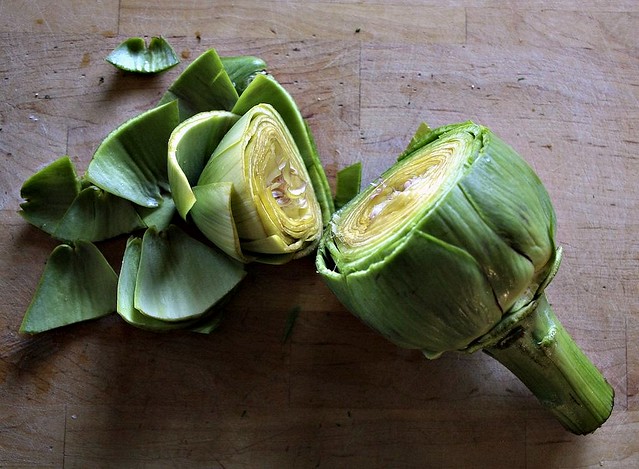
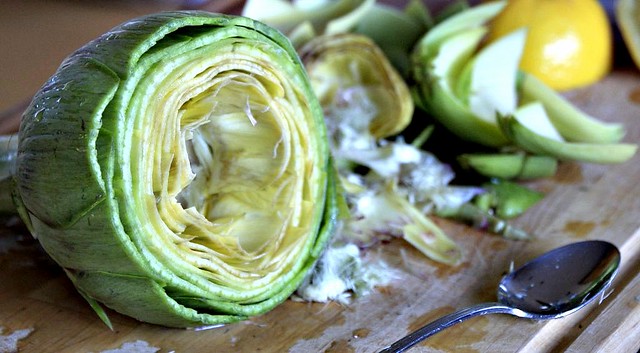
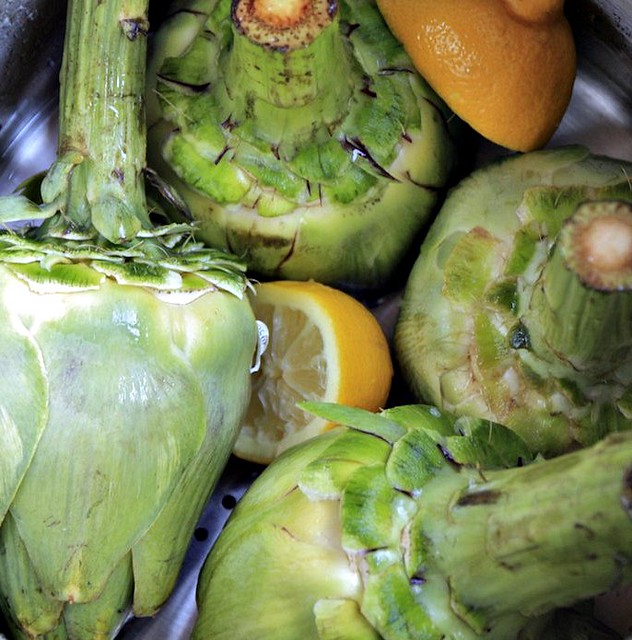
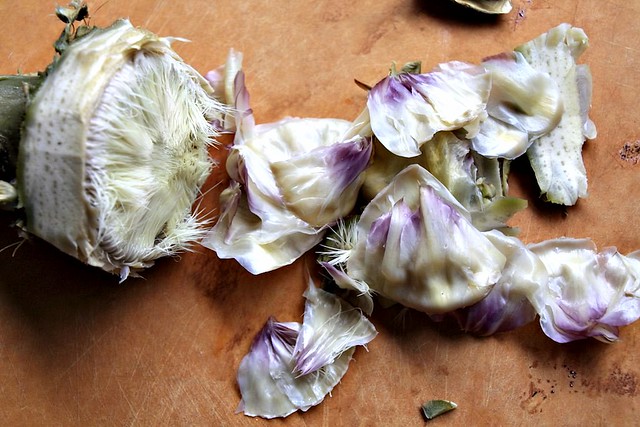
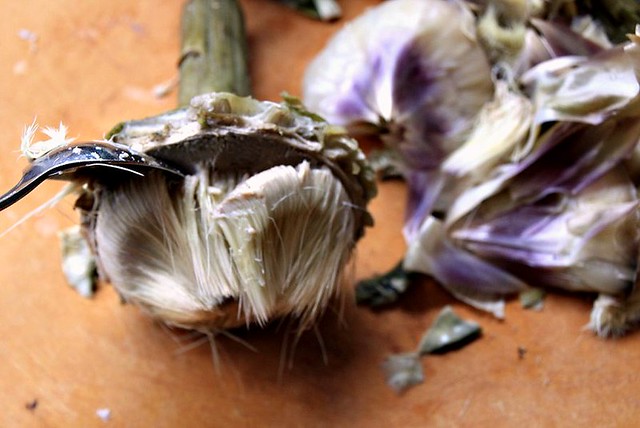
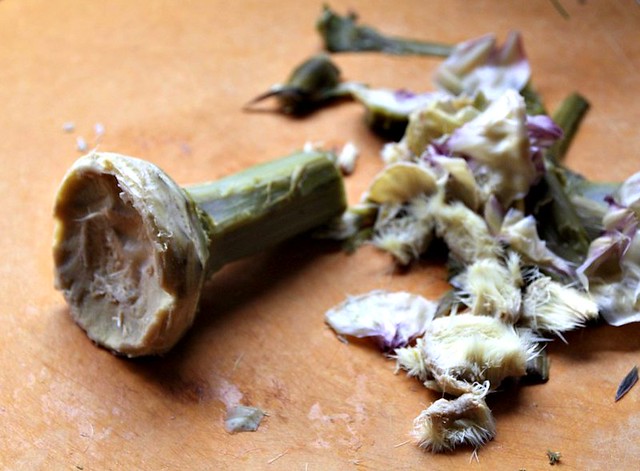
Notes:
- Ocean Mist Farms has excellent information about artichokes in general. There are some great recipes included as well.
- When I set out to cook the artichokes, I wasn’t sure about what I’d put in them, but wanted to experiment with basic preparation. Along the way, I pulled out the French Laundry cookbook and entertained using their method of preparation which essentially puts the artichokes into a stew of sorts — artichokes in liquid with other vegetables and seasonings to provide flavor and prevent discoloring. Although this initially appealed to me, the method of preparing the artichokes for that stew didn’t. Removing all but 1/3 of the artichoke and nearly all of the petals, then digging out the raw choke seemed ridiculous. Not only was I annoyed by the sheer waste of most of a perfectly good artichoke, digging out the choke while that vegetable was raw is quite the challenge. I tried it with two of my four artichokes, sacrificing only 1/3 of the top and removing not so many of the petals before deciding to stop.
- At this point, a good compromise for me would be to place the artichokes whole in Chef Keller’s “stew,” enjoy the petals as we normally would, then prepare the hearts as I’ve described above.
- The pilaf recipe was adapted from one published in Susana Hoffman’s The Olive and the Caper: Adventures in Greek Cooking (Workman, 2004), a wonderfully rich resource I recently added to my cookbook collection. It is a pleasure to read for more than the rich assortment of recipes from Cyprus, Crete, The Cyclades and The Ionian Islands as well as mainland Greece. It is packed with cultural tidbits, historical legends and fact, as well as geographical information about Greece. Detailed information about how to fold and stuff filo includes a recipe to make your own. Recipes for savory pies, delicious soups, a rich variety of pilafs, breads, sauces, and traditional puddings will have you thinking about more than tzatziki or an Americanized Greek salad. It is truly an exceptional resource.
More Artichoke Recipes:
- Artichoke, Leek, and Potato Frittata — Goodlife Eats
- Artichoke, Kale & Ricotta Pie — the kitchn
- Penne with Artichokes — Cooking on the Side
- Artichoke Lasagna – Pastitsio — Kopiaste..to Greek Hospitality
- BBC Recipie: Baked Artichokes Stuffed with roquefort and Walnuts — French Revolution Blog
